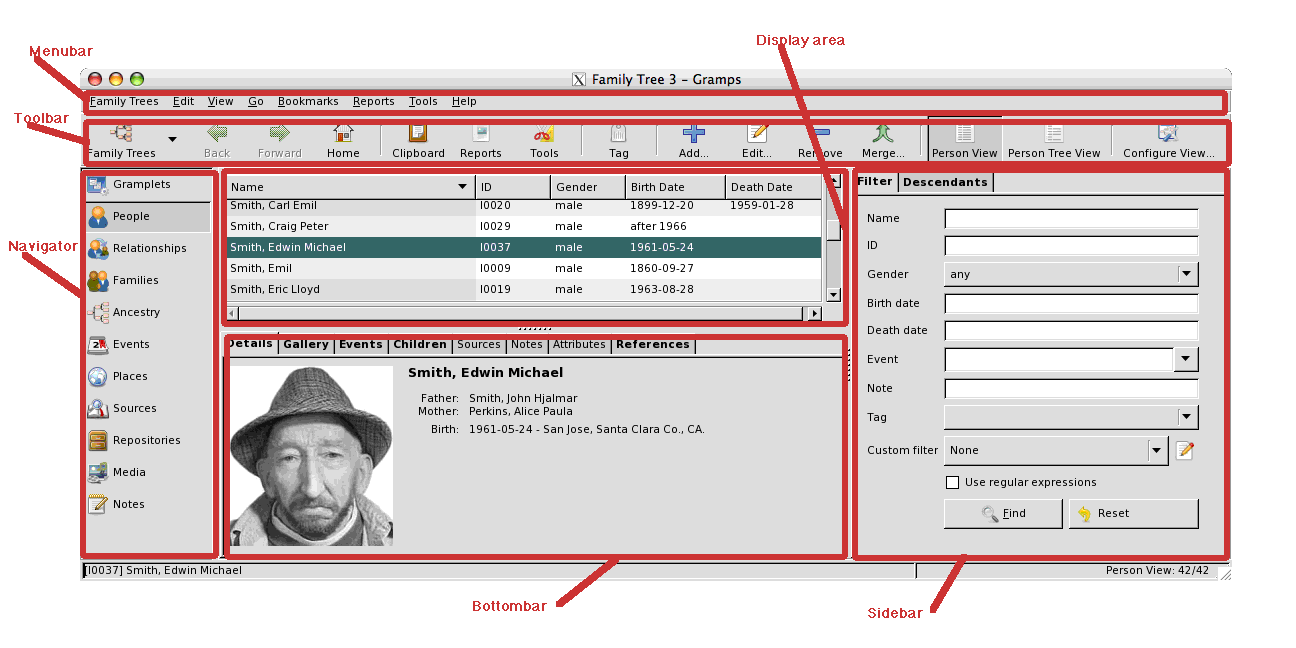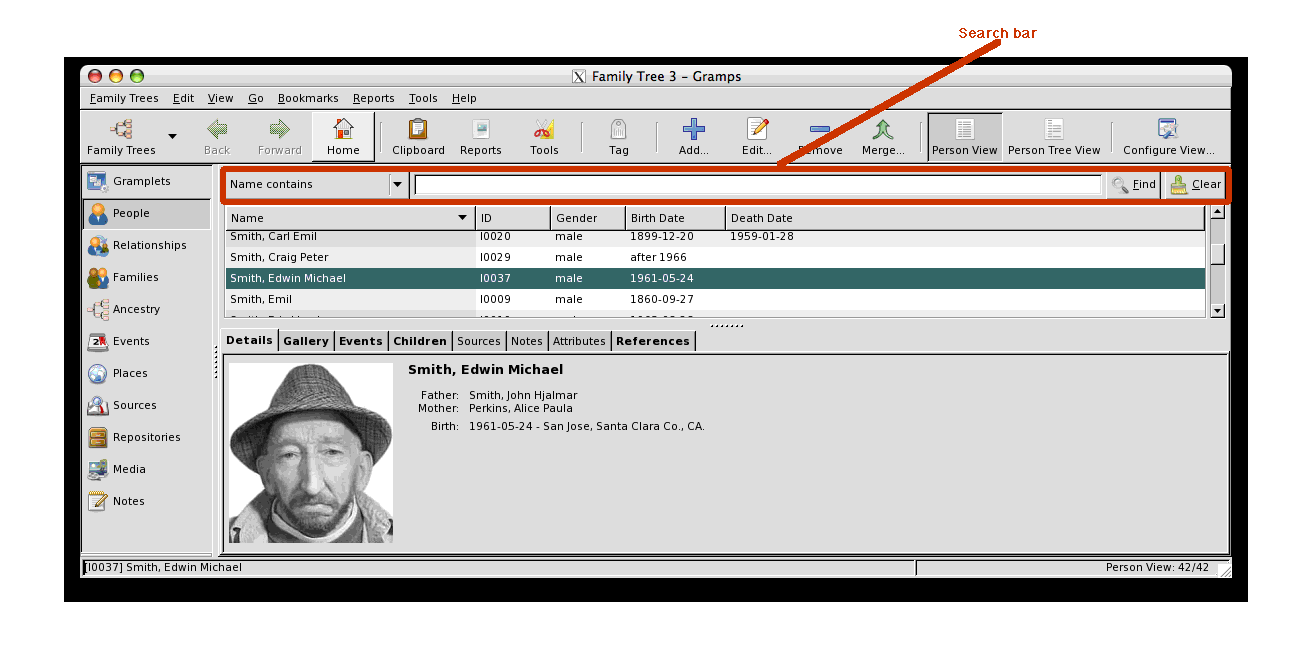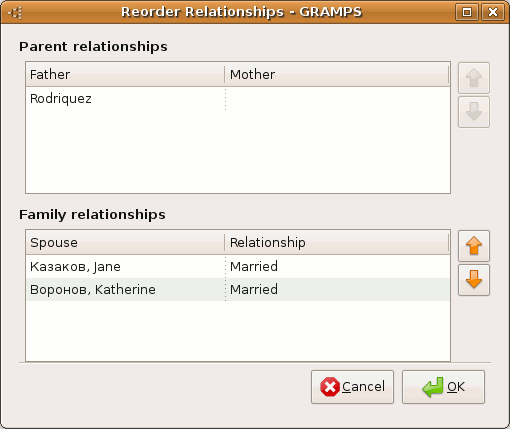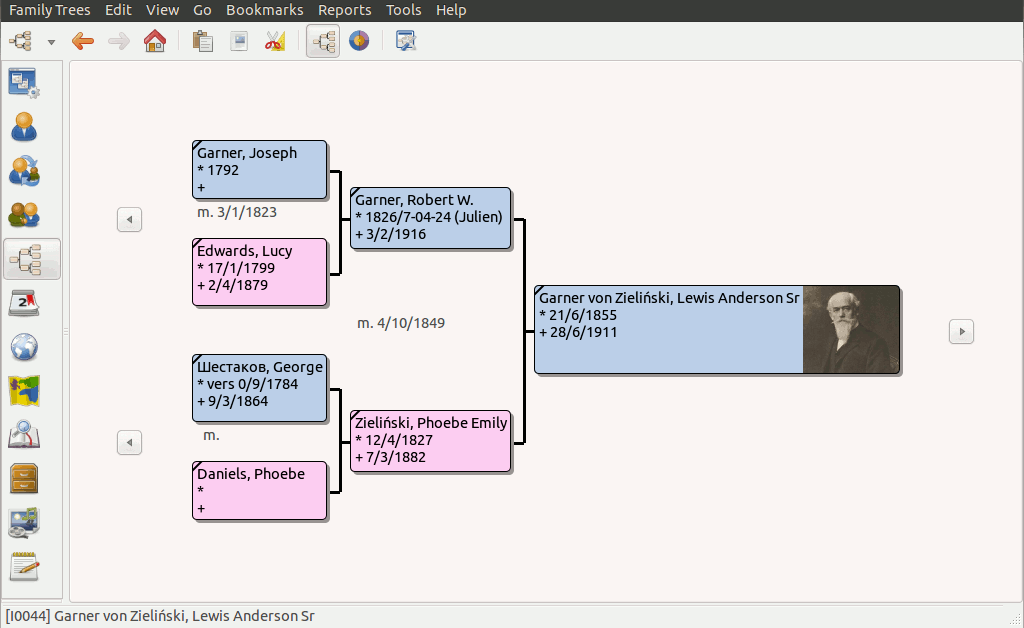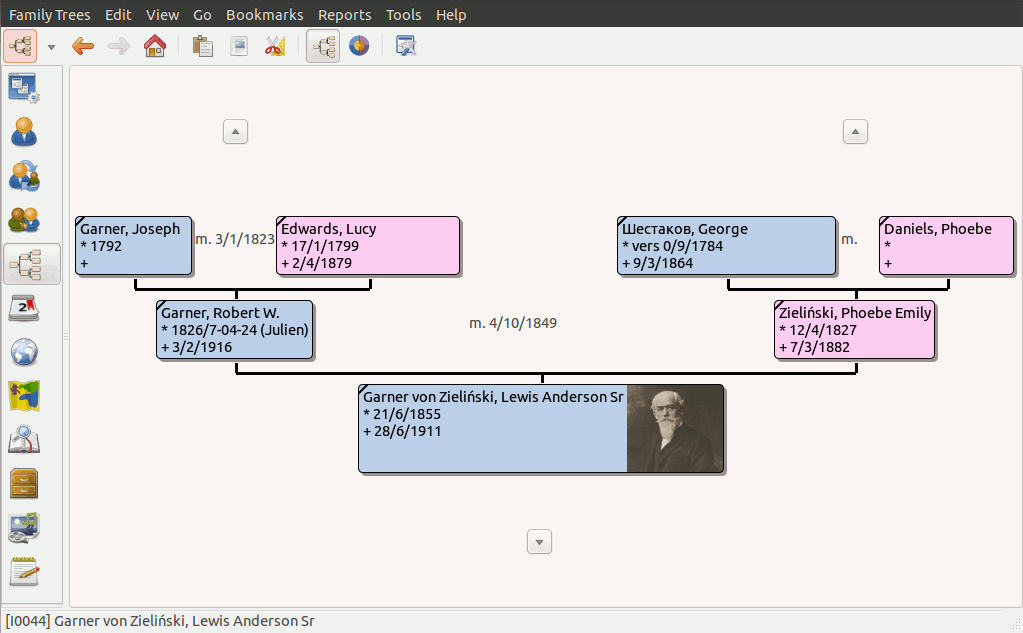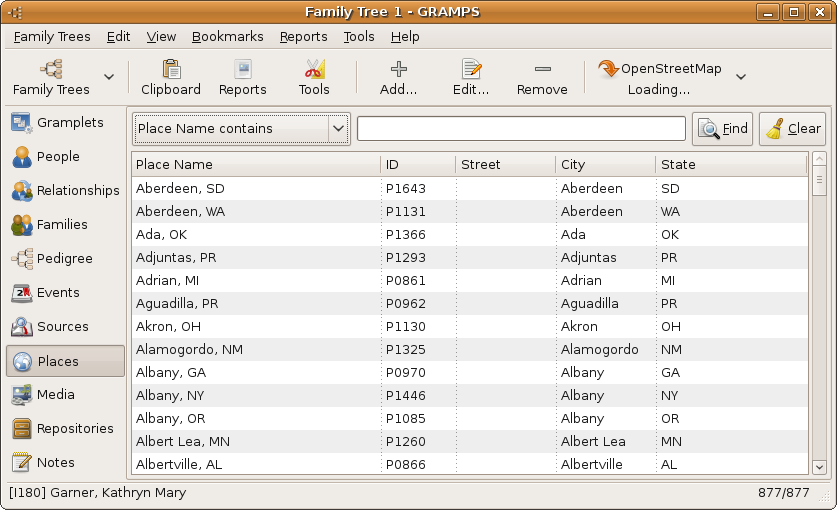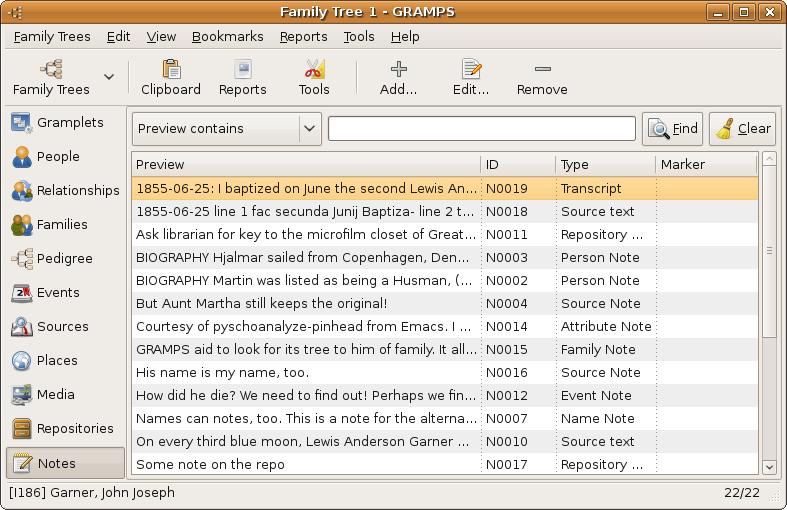Gramps 3.3 Wiki Manual - Main Window

|
Special copyright notice: All edits to this page need to be under two different copyright licenses:
These licenses allow the Gramps project to maximally use this wiki manual as free content in future Gramps versions. If you do not agree with this dual license, then do not edit this page. You may only link to other pages within the wiki which fall only under the GFDL license via external links (using the syntax: [https://www.gramps-project.org/...]), not via internal links. |
| Previous | Index | Next |
| Languages: |
English • Deutsch • suomi • français • italiano • македонски • norsk bokmål • Nederlands • polski • português • русский • shqip • slovenčina |
Contents
- 1 Introduction
- 2 The different Categories
- 3 Switching Views and Viewing Modes
- 4 Gramplets Category
- 5 People Category
- 6 Relationships Category
- 7 Families Category
- 8 Ancestry Category
- 9 Events Category
- 10 Sources Category
- 11 Places Category
- 12 Geography Category
- 13 Media Category
- 14 Repositories Category
- 15 Notes Category
Introduction
When you open a Family Tree database (either existing or new), the main Gramps window is displayed (Fig. 2.1):
The main Gramps window contains the following elements:
- Menubar: The menubar is located at the very top of the window (right below the window title) and provides access to all the features of Gramps.
- Toolbar: The toolbar is located right below the menubar. It gives you access to the most frequently used functions of Gramps. You can set options that control how it appears by going to the menu Edit ->Preferences . You can also hide the toolbar entirely by going to the menu View ->Toolbar.
- Navigator: The navigator is located at the left of the window and allows selection of the different categories.
- Progress Bar and Status Bar: These are located at the very bottom of the Gramps window.
- The Progress Bar is located in the lower left corner of the Gramps window. It displays the progress of time consuming operations, such as opening and saving large Family Tree databases, importing and exporting to other formats, generating web sites, etc. When you are not doing these types of operations, the Progress Bar is not shown.
- The Status Bar is located to the right of the Progress Bar. It displays information about current Gramps activity and contextual information about the selected items.
- Display area: The area in the center of the Gramps window is the display area. What it displays depends on the currently selected View. We will discuss Views in detail below.
- Bottombar: The bottombar is located below the display area.
- Sidebar: The sidebar is located to the right of the display area.

|
TODO Need to update this content. eg fig 2.1 again? |
The Bottombar and the Sidebar allow gramplets to be displayed alongside a view. (Details to be provided, based e.g. on GEPS 019 and Gramps bar, with references to Filters, Filters and Sidebar and bottombar)
The Navigator, Toolbar, Sidebar and Bottombar can be individually turned on or off by options in menu View. If the Sidebar is not displayed, then the Search bar is displayed instead.
The different Categories
Genealogical information is very broad and can be extremely detailed. Displaying it poses a challenge that Gramps takes on by dividing and organizing the information into a series of Categories, each with their own Views. Each View displays a portion of the total information, selected according to a particular category. This will become clearer as we explore the different Categories.
The different Categories of the Navigator: The navigator is located at the left of the window and allows selection of the different categories (See: Fig. 2.1)
 Gramplets: Displays different Gramplets, small widgets that can help in your genealogical research.
Gramplets: Displays different Gramplets, small widgets that can help in your genealogical research.
 People: Displays the people in the family tree without their connections. This Category contains the PeopleListView and the PeopleTreeView.
People: Displays the people in the family tree without their connections. This Category contains the PeopleListView and the PeopleTreeView.
 Relationships: Shows the relationships between the Active Person and other people in a textual way. This includes parents, spouses, and children.
Relationships: Shows the relationships between the Active Person and other people in a textual way. This includes parents, spouses, and children.
 Families: Shows the families in the family tree.
Families: Shows the families in the family tree.
 Ancestry: Displays graphical trees for the selected person.
Ancestry: Displays graphical trees for the selected person.
 Events: Displays the events in the family tree.
Events: Displays the events in the family tree.
 Places: Displays the places in the family tree.
Places: Displays the places in the family tree.
 Geography: Displays data of your family tree on a map.
Geography: Displays data of your family tree on a map.
 Sources: Displays the sources in the family tree.
Sources: Displays the sources in the family tree.
 Repositories: Displays the repositories in the family tree.
Repositories: Displays the repositories in the family tree.
 Media: Displays the media objects in the family tree.
Media: Displays the media objects in the family tree.
 Notes: Displays the notes in the family tree.
Notes: Displays the notes in the family tree.
The categories can contain several ways of presenting the data. Each specific way is called a View. Before we launch into a description of each View, let's first explain how to switch between Views.
Switching Views and Viewing Modes
Gramps comes with number of different Categories as standard. New Categories may be made with plugins you download. There are two different Viewing Modes. You can tell at a glance which Viewing Mode you are in: If you see icons listed vertically in a sidebar at the left of the window, you are in the Sidebar Viewing Mode (see Fig 2.2).
When you are in the Sidebar Viewing Mode, you can select the Category you want by clicking one of the sidebar icons.
Or you can also use the keyboard shorts CTRL+P and CTRL+N go to previous or next category.
As mentioned, a category can contain different ways of presenting the data, called a View. If there are several views, you can switch between the views on the toolbar as each view will have an icon button. You can also switch via the menu View, or by pressing CTRL+<number>, where <number> is the view you want in this category.
Gramplets Category
This contains the Gramplet View, which shows a number of widgets, called Gramplets, that can help you in your research. Two Gramplets are shown on start-up (the Welcome and Top Surname Gramplets). By right-clicking on the Gramplet View, a popup comes up with the possibility of adding other Gramplets.
- Age on Date Gramplet - see the people alive and their ages on a particular date
- Age Stats Gramplet - see age span graphs
- Attributes Gramplets - see active person's attributes
- Calendar Gramplet - see people's events on a particular date, or in a month in the past
- Descendants Gramplet - see the active person's descendants
- Fan Chart Gramplet - see the active person's pedigree, in a circular fan chart
- Given Name Cloud Gramplet - most popular given names
- Pedigree Gramplet - see a complete pedigree in compressed text
- Quick View - run a Quick View on the current person
- Records Gramplet - see world's records of your data
- Relatives Gramplet - see the relatives of the active person
- Session Log Gramplet - keep track of what you have done, and what records you have visited
- Statistics Gramplet - see stats on the database
- Surname Cloud Gramplet - most popular surnames as a "text cloud"
- TODO Gramplet - a notepad to keep tabs on your research
- Top Surnames Gramplet - top 10 most popular surnames
- Welcome Gramplet - a GRAMPS welcome message
- What's Next Gramplet - what needs to be done next
In addition, there are a number of additional Gramplets that you can easily install and use. These include:
- Headline News Gramplet - current, breaking news from GRAMPS
- Data Entry Gramplet - edit active person's name, birth date and place, death date and place, and add people
- Python Gramplet - a Python shell
- FAQ Gramplet - frequently asked questions
- Note Gramplet - see and edit active person's primary Person Note
and many others. See Third-party Plugins for more details.
For more detailed information on using the installed Gramplets, see Gramplets.
People Category
TreeView and ListView
Configuration
The People View lists the people stored in the database(See Fig. People ListView). People are grouped according to their family names. To the left of each family name is typically either an arrow or some other type of indicator (eg: +). Clicking it once will reveal the entire list of people sharing that name. Clicking the indicator again will "roll up" the list and show only the family name.
By default, the People View List, displays several columns of information about each person. You can add or remove columns to and from the display by calling up the Column Editor dialog from the menu View -> Configure View... or click on toolbar Configure View... button and then checking or unchecking the boxes listed. You can also change the position of a column in People View by clicking and dragging it to a new position in the Editor (drag and drop). Once you have made the changes you want, click OK to exit the Editor and see your changes in the People View.
Column Editor The Column Editor is available in all Views and works the same way in each. |
Filters
Genealogical databases can contain information on many people, families, places, and objects. It is therefore possible for a View to contain a long list of data that is difficult to work with. Gramps gives you two different means for controlling this condition by allowing you to filter a list to a more manageable size.
These methods are Search and Filtering.
A search will search the text displayed in list, whereas filters display people whose data match the criteria of the filter. Search is a simple but fast method of searching the columns displayed on the screen. Typing the characters into the Search box and clicking the Find button will display only lines that match the text.
Alternatively, you can enable the Filter sidebar, which will be displayed on the right hand side of the display. When the filter sidebar is displayed, the Search bar is not displayed. The Filter side bar allows you to interactively build a set of filter rules that can be applied to the display. The filter is applied based on the rules and the data, not on the screen display.

|
Searching vs. Filtering Searching only searches for exact text matches. If the date displayed is "Jan 1, 2000", a search of "1/1/2000" will fail, but a filter of "1/1/2000" will match. |
When Gramps opens a database, no filtering is in effect. In People View, for example, all people in the database are listed by default.
Sorting columns

|
TODO Need to update this content. To be written. |
Relationships Category
The Relationships View displays all the relationships of the Active Person (the selected person). Specifically, it shows his or her parents, siblings, spouses, and children.
The Relationships View is designed to allow for quick navigation. You can quickly change the Active Person simply by clicking the name of any person listed on the page. Each name is actually a hypertext link, similar to a web page.
The name of the Active Person is in bold style. Other names are shown either with or without bold and italic emphasis depending on whether certain relationships exist for the named person. For a person listed as a parent or spouse of the Active Person, the name is emphasized if that person has a parent family. For a person listed as a sibling or child of the Active Person, the name is emphasized if that person has children.
Dates are normally in regular style, and in italic style if the displayed event is a fallback event, i.e., a substitute event for another missing event. That may be christening event for birth event, burial event for death event, etc.
The Relationships View displays the following sections:
- Active Person: At the top of the screen, name, ID, birth, and death information, calculated age of the Active Person is displayed. If a photo of the person is available, it is shown on the right hand side. Next to the person's name is a symbol indicating gender, and an Edit button. Clicking the Edit button will allow you to edit all of the person's individual information in an Edit Person dialog.
- Parents: The next section, the Parents section, displays the families in which the person is a child. Since it is possible for a person to have multiple sets of parents, it is possible to have several Parents sections.
You can control how much information is displayed by using the View menu. The view menu allows you to show or hide details (the birth and death information) and to show or hide siblings. Next to each person listed is an Edit button, which will allow you to edit all the details of that particular person.
You may add a set of parents by either selecting the Add Parents or the Share Parents buttons. The Add Parents button will create a new family with the Active Person listed as a child. The Share Parents button will allow you to choose from a list of existing families, and then add the person as a child to that family.
You may edit an existing parents by selecting the Edit button next to the parents. If you select the Delete button next to a set of parents, then the Active Person will be removed as a child from the parents. This button does not delete the parents' relationship.
- Family: Similar to the Parents section is the Family section, which displays families where the Active Person is a parent. Because it is possible to have multiple families, it is possible to have multiple Family sections. Each family section displays the spouse and any children.
You may add a family by selecting the Add Spouse button in the toolbar. This will create a new family with the Active Person listed as a father or mother.
Selecting the Edit button next to the spouse will allow you to edit the displayed family. Clicking the Delete button will remove the person from the displayed family.

|
Removing a person from a family Removing a person from a family does not delete the family. The person is removed as the father or mother, and any other relationships in the family continue to exist. |
You can reorder the parents and spouses by selecting the Reorder button. This option will only be enabled if more than one set of parents or more than one set of spouses exists for the Active Person. Selecting this button will display a dialog that will allow you to reorder the families.
Configuration
You can configure the view from the display by calling up the Configure dialog from the menu View -> Configure... or click on the toolbar Configure View... button.
Families Category
The Family List View displays a list of all families in the database(see Fig. 2.9). From this view, you may add, edit, or delete families. The default display lists the ID, Father, Mother, Relationship and Marriage Date. Children cannot be displayed on the screen in this view.
Ancestry Category
The Ancestry Category shows several graphical representations of the ancestry of the active person. By default Gramps shows the Pedigree View; With the Fan Chart View being selectable from the toolbar. Installation of additional downloadable addons contain extra views.
Pedigree View
The Pedigree View shows up to five generations, depending on the size of the window. Each person is indicated by a box labeled with his or her name, birth and death information, and optionally an image if available. Two lines branch from each box. The top one shows the person's father and the bottom one the mother. Solid lines represent birth relations, while dashed lines represent non-birth relations such as adoption, step-parenthood, guardianship, etc.
To the left of the Active Person is a left arrow button. If the Active Person has children, clicking this button expands a list of the Active Person's children. Selecting one of the children makes that child the Active Person.
The appearance of the children's names in the menu differentiates the dead ends of the tree from the continuing branches.
Children who have children themselves appear in the menu in the boldface and italic type, while children without children (dead ends) appear in a regular font. If the Active Person has only one child, no menu will be displayed (since there is only one choice) and the child will become the Active Person when the arrow button is clicked.
The right-hand side of the window shows two right arrow buttons. When the top button is clicked, the Father of the Active Person becomes the Active Person. When the bottom button is clicked, the Mother of the Active Person becomes the Active Person.
Right-clicking on any person's box in the Pedigree View will bring up the "context menu".
Among other useful items, the context menu has sub-menus listing Spouses , Siblings , Children , and Parents of that person.
"Greyed-out" sub-menus indicate the absence of the data in the appropriate category. Similar to the children menu above, Childrens' and Parents' menus distinguish continuing lines from dead ends.
Fan Chart View
This view shows the ancestry but as a pie chart. Clicking on a name in the chart will double the section of the pie allocated to that person. A second click brings the chart back to the original form. Right click brings up a context menu like in the pedigree view, allowing to navigate to other people.
This view enables to see large ancestries in a more compact manner, and to see very quickly which parts of an ancestry need further research.
You can rotate the view by click and drag outside the fan chart. You can move the view by click and drag inside the inner (white) region.
Events Category
Events can be shared between multiple people and multiple families. The Events View lists the all the events recorded in the database.
The columns available for display are: Description , ID , Type , Main Participants , Date , Place and Last Changed.
The default view displays the Description , ID , Type , Date and Place of the event. The Column Editor dialog can be used to add, remove and rearrange the displayed columns. This can be accessed from the Configure View... button on the toolbar.
The list of Events can be sorted in the usual manner, by clicking on the column heading. Clicking once sorts in ascending order, clicking again sorts in descending order.
Sources Category
Sources View lists the sources of certain information stored in the database.
These can include various documents (birth, death, and marriage certificates, etc.), books, films, journals, private diaries, - nearly anything that can provide genealogical evidence. Gramps gives you the option to provide a source for each event you record (births, deaths, marriages, etc.). The Sources View lists the Title , ID , and Author of the source, as well as any Publication information that may be associated with it.
The list of Sources can be sorted by clicking on a column heading.
Clicking once sorts in ascending order, clicking again sorts in descending order. The Column Editor dialog can be used to add, remove and rearrange the displayed columns.
Places Category
The Places Views lists the geographical places in which the events of the database took place. These could be places of birth, death, and marriages of people, as well as their home, employment, education addresses, or any other conceivable reference to the geographical location. The Places View lists the places' Name , ID , Church Parish , City , County , State , and Country . All of these columns can be used for sorting by clicking on a column heading.
Clicking once sorts in ascending order, clicking again sorts in descending order. The Column Editor dialog may be used to add, remove and rearrange the displayed columns.
If a place has been highlighted, you may select the Google Maps, loading... button to attempt to display the place in a web browser. The map service can be chosen from the drop down list under the black triangle to the right of the map button.
Your default web browser should open, attempting to use either the longitude and latitude coordinates or the place name to display the location using the Google Maps web site. Different map services might have different requirements for the location description.
This feature is limited, and may not always produce the results you desire.
PlaceTreeView and PlaceListView
The two views in this category show the places grouped or ungrouped. The PlaceTreeView tries to group the places in logical groups: country, county, ... .
This view is new in Gramps version 3.3.0. (In future versions the aim is to make the grouping more intelligent. ???)
The PlaceListView on the other hand just shows all the places in one long list.
Geography Category

|
Note The Geography category is only present if OsmGpsMap is present that Gramps can use. |
This category is for showing data on a map. It contains the Geographic View, which allows you to see the people and their events placed on a map via an internet map provider (OpenStreetMap or Google maps).
The Geographic View can:
- show all places in your family tree
- show a filtered selection of places
- show all places connected to the active person
- show all places connected to the active family
- show all places connected to all events
- show all places connected to a filtered selection of events
These options are accessible via the buttons on the toolbar. To filter on places or events, activate the filter sidebar via the menu View->Filter Sidebar
Furthermore, the Geographic view can help you add new places to your family tree, or add latitude-longitude coordinates to existing places. To activate this, use the add location button, or the link location button in the toolbar.
The top of the Geographic View shows two lines with information, allowing you to change the information shown. The second line always shows in bold what is shown on the map.
The first line has:
- Place list button and selection field.
- The button shows how many places are present in the map. The selection fields allows you to jump to one of these places. You can clear the selection field by clicking the places list button.
- Place page buttons
- If there are many places, the map is no longer useful because too much information is shown. Therefore, the places will be divided in pages. You can navigate the pages and see the map change via the Place page buttons: << goes back a page, >> goes forward a page, and the middle button shows how many pages there are and what is shown at the moment.
- Places with no latitude-longitude
- The Geographic View can only show places with a valid latitude-longitude. A list of all places that satisfy the selection, but cannot be put on the map, is available via the button with a number and the ? sign. You can add latitude-longitude to these places in one of the following ways:
- Use the place link button on the Geographic View
- Go to the Place View, and use the Go button to search the place and it's location
- Download the Place completion tool via the menu Help->Plugin Manager. If you download the data of your country, this tool can add latitude-longitude to all your places.
- lock zoom level.
- If you zoom the map to a resolution you want to keep, then you can press the lock zoom level button, and every time the Geographic View redraws the map, this zoomlevel will be used.
- provider selection change
- Gramps uses OpenStreetMap or Google Maps to provide the map that is displayed. With this button you can quickly change from one to the other. The advantage of OpenStreetMap is that it is a free project, so you can update the maps yourself with missing information via their website.
Via the toolbar Configure View... button (or via the menu View, the following functionality is available:
- Map options
- add crosshair in center of map, usefull to add or link places to the correct latitude-longitude coordinates
- show coordinates in the statusbar
- Time period: this changes how the view divides events in groups
- Network: This view needs an internet connection. If your connection drops away from time to time, or is not always on, you can set here to have the Geographic view retry the internet connection. Like this, the Geographic view will become active the moment your internet connection returns, without you needing to take manual action.
Media Category
The Media View is a list of Media Objects used in the database.
Media Objects are any files that relate somehow to the stored genealogical data.
Technically, any file can be stored as a Media Object.
Most frequently, these are images, audio files, animation files, etc. The list box on the bottom lists the Name , ID , Type , and Path of the Media Object.
The Column Editor dialog may be used to rearrange the displayed columns, which obey usual sorting rules. The top part of the Gramps window shows a preview (if available) and information about the Media Object.
Repositories Category
A repository can be thought of as a collection of sources.
Each source in the database can reference a repository (such as a library) in which it belongs. The functionality of the Repositories View is similar to the other views.
Notes Category
A Note is pure text, as stored in the other objects.
The functionality of the notes View is similar to the other views. The view lists all Notes stored in the Family Tree. Using the menu View ->Configure View... you open the Column Editor and you can change the displayed columns. The possibilities are Preview, ID, Type and Marker.
The Type can be (amongst others): Event Note, Address Note,Source text, Place Note
Double-clicking on a Note in the list will bring up a window where you can edit the Note. You can change fonts, font color and background color. A spellchecker is available for English and your local language.
| Previous | Index | Next |
| Languages: |
English • Deutsch • suomi • français • italiano • македонски • norsk bokmål • Nederlands • polski • português • русский • shqip • slovenčina |
